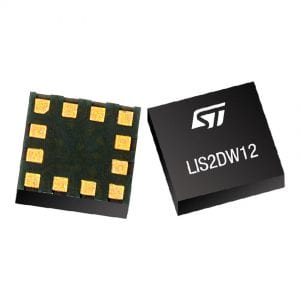LIS2DW12 is the new accelerometer from ST that will greatly improve IoT and wearable devices. A fundamental paradox in modern electronics is that as a product becomes smaller, its use cases become more numerous and varied. Usually, a bigger canvas means more choices, and opportunities, yet when the phone was a brick, its feature list was very small, and as it shrank, it became a computer, game console, and health monitor. Its list of applications just keeps on growing as it keeps on shrinking and its features move to smartwatches.
The problem is that it is counterintuitive to the nature of electrical circuits, because shrinking a design implies compromises that limit its capabilities. Hence, engineers are faced with non-trivial and often contradictory constraints and considerations. To answer this dilemma in a unique fashion, ST is announcing the LIS2DW12, a three-axis accelerometer, and temperature sensor, which offers a level of granularity that has never been seen before in this type of component.
Fine Tuning LIS2DW12

Compared to the LIS2DS12 that was announced last summer, the new LIS2DW12 offers a lot of the same features. Both have user-selectable full-scale ranges measuring acceleration (±2g, ±4g, ±8g, and ±16g), an identical temperature range of -40ºC to +85ºC, 16-bit data output, and 10,000 g high-shock survivability in an extremely small package of only 2 mm x 2 mm x 0.7 mm.
What sets the LIS2DW12 apart is its levels of customization. Engineers have the possibility to turn on or off a special Low Noise feature, they can also choose between a high-performance mode, four low-power modes, and nine different output data rates. Hence, each configuration can help find the balance between power consumption and signal integrity, with unparalleled precision. The table below offers just a glimpse of the different combinations that can optimize a system at the single digit micro amp level. An exhaustive list is available in the application note of the component.
| Modes | Resolution | Noise density | @ 12.5 Hz | @ 200 Hz |
|---|---|---|---|---|
| Low Noise OFF – High Performance | 14-bit | 110 µg/√Hz | 90 µA | 90 µA |
| Low Noise ON – High Performance | 14-bit | 90 µg/√Hz | 120 µA | 120 µA |
| Low Noise OFF – Low Power Mode 4 | 14-bit | 160 µg/√Hz | 4 µA | 63 µA |
| Low Noise ON – Low Power Mode 4 | 14-bit | 130 µg/√Hz | 5 µA | 77 µA |
| Low Noise OFF – Low Power Mode 3 | 14-bit | 210 µg/√Hz | 2.5 µA | 34.5 µA |
| Low Noise ON – Low Power Mode 3 | 14-bit | 180 µg/√Hz | 3 µA | 42 µA |
| Low Noise OFF – Low Power Mode 2 | 14-bit | 300 µg/√Hz | 1.6 µA | 20.5 µA |
| Low Noise ON – Low Power Mode 2 | 14-bit | 240 µg/√Hz | 2 µA | 25 µA |
| Low Noise OFF – Low Power Mode 1 | 12-bit | 550 µg/√Hz | 1 µA | 10 µA |
| Low Noise ON – Low Power Mode 1 | 12-bit | 450 µg/√HZ | 1.1 µA | 12 µA |
Power Costs

As ST’s latest 16-bit “femto” accelerometer, the LIS2DW12 offers amazing power savings, which remain crucial in designs relying on a battery. With a current consumption of only 50 nA in power-down mode, and a draw of only 0.38 µA at 1.6 Hz in Low Power Mode 1 and Low Noise OFF, manufacturers can add more features, while improving their product’s battery life.
Clearly, the power improvements over the older LIS2DS12 are phenomenal. In contrast, the previous chip required a current of 0.7 µA in power-down, and demanded 2.5 µA in its low-power mode. However, the increase in efficiency came at the small expense of the buffer size. Whereas the LIS2DS12 has a 256-level FIFO (First In First Out), the LIS2DW12 has only 32 levels. This memory enables the system to store data from the sensors until the host MCU wakes up. More levels mean the system can wait longer before turning the host processor on. However, the LIS2DW12 is aimed at IoT and wearable, which are devices that often wake up for various reasons, like a smartwatch updating the system’s step counter. Furthermore, the smaller FIFO represents only a small hit on the overall power consumption, which pales in comparaison to the record-low current consumption made possible by the new architecture.
LIS2DW12 : More Applications With Smaller Devices
As a result, it will be simpler and more efficient to include features like double-tap detection, which is at the foundation of mobile payment solutions. Being able to distinguish between a user’s periods of activity and inactivity will be a lot more optimized, and because of the integrated engine, free-fall recognition or portrait/landscape detection will take even less time, greatly enhancing the user’s experience. Engineering samples of the LIS2DW12 are available, and mass production is expected to start in Q1, 2017. To stay up to date on the latest technologies from ST, check out the life.augmented blog. To know more about the LIS2DW12, please visit ST’s website.




